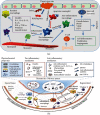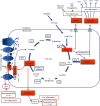The Dynamic Inflammatory Tissue Microenvironment: Signality and Disease Therapy by Biomaterials
- PMID: 33623917
- PMCID: PMC7879376
- DOI: 10.34133/2021/4189516
The Dynamic Inflammatory Tissue Microenvironment: Signality and Disease Therapy by Biomaterials
Abstract
Tissue regeneration is an active multiplex process involving the dynamic inflammatory microenvironment. Under a normal physiological framework, inflammation is necessary for the systematic immunity including tissue repair and regeneration as well as returning to homeostasis. Inflammatory cellular response and metabolic mechanisms play key roles in the well-orchestrated tissue regeneration. If this response is dysregulated, it becomes chronic, which in turn causes progressive fibrosis, improper repair, and autoimmune disorders, ultimately leading to organ failure and death. Therefore, understanding of the complex inflammatory multiple player responses and their cellular metabolisms facilitates the latest insights and brings novel therapeutic methods for early diseases and modern health challenges. This review discusses the recent advances in molecular interactions of immune cells, controlled shift of pro- to anti-inflammation, reparative inflammatory metabolisms in tissue regeneration, controlling of an unfavorable microenvironment, dysregulated inflammatory diseases, and emerging therapeutic strategies including the use of biomaterials, which expand therapeutic views and briefly denote important gaps that are still prevailing.
Copyright © 2021 Rani Mata et al.
Conflict of interest statement
There are no conflicts of interest to declare.
Figures






Similar articles
-
Inflammation and metabolism in tissue repair and regeneration.Science. 2017 Jun 9;356(6342):1026-1030. doi: 10.1126/science.aam7928. Epub 2017 Jun 8. Science. 2017. PMID: 28596335 Review.
-
The inflammasome in host response to biomaterials: Bridging inflammation and tissue regeneration.Acta Biomater. 2019 Jan 1;83:1-12. doi: 10.1016/j.actbio.2018.09.056. Epub 2018 Sep 29. Acta Biomater. 2019. PMID: 30273748 Review.
-
Promoting tissue regeneration by modulating the immune system.Acta Biomater. 2017 Apr 15;53:13-28. doi: 10.1016/j.actbio.2017.01.056. Epub 2017 Jan 22. Acta Biomater. 2017. PMID: 28119112 Review.
-
Interrelation of immunity and tissue repair or regeneration.Semin Cell Dev Biol. 2009 Jul;20(5):517-27. doi: 10.1016/j.semcdb.2009.04.009. Epub 2009 Apr 22. Semin Cell Dev Biol. 2009. PMID: 19393325 Review.
-
Macrophages and fibroblasts during inflammation and tissue repair in models of organ regeneration.Regeneration (Oxf). 2017 Jun 6;4(2):39-53. doi: 10.1002/reg2.77. eCollection 2017 Apr. Regeneration (Oxf). 2017. PMID: 28616244 Free PMC article. Review.
Cited by
-
Single-Cell Microgel Encapsulation Improves the Therapeutic Efficacy of Mesenchymal Stem Cells in Treating Intervertebral Disc Degeneration via Inhibiting Pyroptosis.Research (Wash D C). 2024 Feb 16;7:0311. doi: 10.34133/research.0311. eCollection 2024. Research (Wash D C). 2024. PMID: 38371273 Free PMC article.
-
Programming of Regulatory T Cells In Situ for Nerve Regeneration and Long-Term Patency of Vascular Grafts.Research (Wash D C). 2022 Jul 19;2022:9826426. doi: 10.34133/2022/9826426. eCollection 2022. Research (Wash D C). 2022. PMID: 35966759 Free PMC article.
-
Exosomes loaded a smart bilayer-hydrogel scaffold with ROS-scavenging and macrophage-reprogramming properties for repairing cartilage defect.Bioact Mater. 2024 Apr 27;38:137-153. doi: 10.1016/j.bioactmat.2024.04.017. eCollection 2024 Aug. Bioact Mater. 2024. PMID: 38699244 Free PMC article.
-
A self-sacrificing anti-inflammatory coating promotes simultaneous cardiovascular repair and reendothelialization of implanted devices.Bioact Mater. 2025 Feb 13;47:502-512. doi: 10.1016/j.bioactmat.2025.01.037. eCollection 2025 May. Bioact Mater. 2025. PMID: 40026826 Free PMC article.
-
The dual role of tissue regulatory T cells in tissue repair: return to homeostasis or fibrosis.Front Immunol. 2025 Mar 6;16:1560578. doi: 10.3389/fimmu.2025.1560578. eCollection 2025. Front Immunol. 2025. PMID: 40114929 Free PMC article. Review.
References
Publication types
LinkOut - more resources
Full Text Sources
Other Literature Sources

